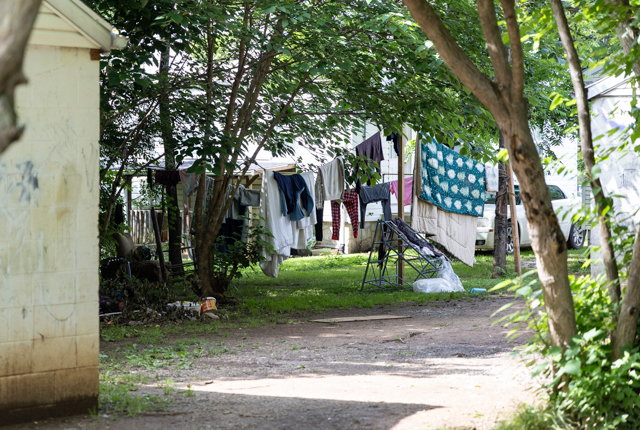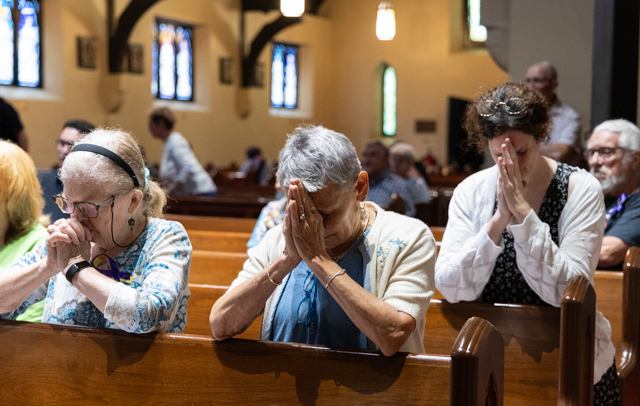Police, victim’s sister testify in Butler County murder trial
Published 12:00 am Saturday, May 30, 2009
MORGANTOWN — Two Kentucky State Police detectives who investigated the slaying of Teresa Childres in Butler County testified Friday on how their efforts led to Dennis Childers emerging as a suspect and eventually being charged with murder, kidnapping and tampering with physical evidence in the 2000 shooting death of Childres, 35.
Meanwhile, Childers’s defense attorney hammered on the absence of physical evidence conclusively linking Childers to the killing.
The trial of Childers, 44, of Morgantown continued Friday in Butler Circuit Court before Circuit Judge Ronnie Dortch, with half of the day’s proceedings devoted to hearing testimony from Sgt. Tommy Smith and Det. Scott Skaggs, both of KSP Post 3 in Bowling Green.
As a state police detective, Smith led the investigation into Childres’s death until his promotion to sergeant in September 2002. Skaggs was assigned the case upon his promotion from patrol officer to detective in 2004.
Aided by video footage and still photographs that he shot of the crime scene on Jan. 15, 2000, shortly after Childres’s body was found near Lawson Embry Cemetery, Smith described the evidence he gathered. The video, taken on that date starting at about 3:30 p.m., shows her partially exposed body lying face down under a pile of leaves against a fence, the back of her head and hands clearly visible.
A trail of upturned leaves could be seen leading from the site of the body to a gravel road. A pair of pink bib overalls had been pulled down to about her knees, and a red flannel shirt and blue T-shirt were found hanging from a nearby tree.
When investigators uncovered the body, it showed that the shirt had been partially pulled up, and gunshot wounds to her neck, chest and back could be seen, along with cuts to the left side of her face.
Those articles of clothing, along with a long-sleeved shirt, a pair of underwear, white socks and brown work boots, were recovered from the scene and entered as evidence in the trial Friday, Smith showing jurors the pink overalls, which were torn and stained in at least one area.
A bullet hole found in the flannel shirt was consistent with the location of one of the three wounds from a 20-gauge shotgun Childres sustained, according to testimony
Smith said he also recovered 20-gauge shotgun shells, two 12-gauge shotgun shells, including one pulled from a tree, a pack of cigarettes, a plastic Dr. Pepper bottle and blood-stained gravel from the scene.
DNA testing of the bottle at the KSP Crime Lab in Frankfort confirmed the presence of Childres’s DNA and that of another unidentified woman on the bottle, Smith said.
The connection between the body and Dennis Childers was established, Smith said, when investigators found a blue piece of paper in one of Teresa Childres’s pockets that featured two phone numbers, with the name “Dennis” written next to one and “David” written next to the other.
The numbers were registered to the residences of Dennis’ father, Leman Childers, and David Cardwell’s father, Morris.
David Cardwell alleges to have been an eyewitness to Teresa Childres’s death and has been offered immunity from prosecution in order to testify.
Police interview Childers
With Smith on the witness stand, Butler County Commonwealth’s Attorney Tim Coleman played an audiotape of Smith’s initial interview with Childers, taken Jan. 15 2000, at the Butler County Sheriff’s Office.
During the 20-minute interview, Childers, speaking with a hoarse voice, claimed only to “know of” Teresa Childres, and gave what sounded like a surprised “Huh?” when he was informed by Smith that Childres had been killed.
“I mean they killed her graveyard dead,” Smith says on the tape.
Asked to explain the phone number in Childres’s pocket, Dennis Childers said he gave her the number so that she could contact him if she needed his help, and later told Smith that Childres said she was scared of a man named Martin Phelps, claiming that Childres told him she was afraid Phelps would hurt her because of graffiti written on a water tower romantically linking Phelps and Childres.
During cross-examination by Childers’s attorney, Gary Logsdon, Smith admitted that tests of a coat and a pair of shoes worn by Childers produced no evidence linking him to the crime scene, and while Smith knew of a Martin Phelps in Butler County, he never took a statement from Phelps, who was disabled by a brain aneurysm in 2004.
“Those were the clothes (Dennis) was wearing when he came to talk to us,” Smith said.
Childers and Ronnie Burden, then the husband of Teresa Childres’s sister, Mary Lisa Johnson, were arrested at Childers’s trailer in May 2000 on drug charges by Smith, but a Buick that Childers was known to drive and was registered to his father was not on the property, preventing state police from analyzing it for evidence in the slaying, Smith said.
“During the period you were responsible for the case, there was no arrest warrant or indictment issued,” Logsdon said to Smith during cross-examination.
Second detective questioned about eyewitness
After Skaggs took control of the case, a break came in 2007 when Skaggs learned that David Cardwell had been arrested and was jailed in Breckinridge County, Skaggs testified.
Skaggs interviewed Cardwell four times between February and August 2007.
“In my view, (Cardwell) definitely had knowledge of the case,” Skaggs said when describing his first interview with Cardwell. “He did not say that verbally, but he was saying that and telling me with his eyes.”
Soon, Skaggs saw Cardwell as someone who could help solve a case that had gone cold.
“I approached him as if, ‘If you aren’t the killer, but you have knowledge of (the shooting), what if I could get the commonwealth attorney not to pursue charges on you,’ and he said, ‘Go see what you can do,’ ” Skaggs said.
After immunity was granted to Cardwell, Skaggs testified that Cardwell admitted his involvement in the death in a series of interviews, claiming to have struck Childres in the head with a hammer while she sat in the front passenger seat of Dennis Childers’s car and he was in the back seat behind Childers.
Skaggs demonstrated the blows Cardwell claimed to have landed with the hammer, swinging his right arm across his body in a backhand motion.
Skaggs said Cardwell also recalled details of Jan. 13, 2000, when authorities believe Childres was killed, that the detective was able to corroborate through interviews with other witnesses.
Among those details were Cardwell’s knowledge of the tape recorder, which Childres had reportedly used while working as a drug informant for the Butler County Sheriff’s Office; and his claim to recollect the pink bib overalls Childres allegedly wore when she was killed, Skaggs testified.
Also, Skaggs said Cardwell drew a sketch of the scene where Childres’s body was found, which had many similarities to a sketch of the crime scene drawn by Smith.
A subsequent interview of Dennis Childers by Skaggs on Nov. 20, 2007, resulted in an inconsistent account of Childers’s actions on Jan. 13, 2000, with Skaggs testifying that Childers claimed to have been out driving all that night with Childres before dropping her off at Corky Kessinger’s residence, then later claiming to have dropped her off at Betty House’s residence, then claiming that Childres walked from Kessinger’s home to House’s, before finally saying it was actually Childers’s then-girlfriend, Gayla Brooks, who drove.
Childers also said he and Cardwell drove to Alabama the day after Childres died during the interview with Skaggs, claiming to the detective that he traveled with Cardwell, who went to pick up his daughter, and recalled buying a pair of shoes, Skaggs testified.
Skaggs’ claims challenged
Logsdon hit on the claims that Childers and Cardwell made to Skaggs during their interviews with him, questioning Skaggs on whether Cardwell’s statements, taken nine years after his alleged involvement in Childres’s death, would be prone to inconsistencies similar to Childers’s statements.
“What … reliability can you point to in Mr. Cardwell’s statements to make you believe what you took?” Logsdon asked.
“The fact that he gave me certain facts I proved about his statements,” Skaggs said.
Logsdon also questioned Skaggs on whether Cardwell would have been able to strike Childres with a hammer and inflict the deep cuts that were found on her head and face, considering where the two were supposedly sitting in the car.
Skaggs, like Smith, also admitted during cross-examination to not have physical evidence linking Childers to the crime.
Sister, friend, coroner testify
Jurors heard testimony from three other people Friday morning, including two of the last people to see Childres alive on Jan. 13, 2000.
Mary Lisa Johnson, Childres’s sister, said during questioning by Coleman that on the day of Childres’s funeral, she discovered a microcassette that she later took to then-Butler County Sheriff Kenneth Morris.
Jurors who listened to the tape Friday heard three different recorded conversations, which Johnson said contained the voices of another sister, Childers and Childers’s then-girlfriend Brooks.
Johnson said that her other sister had spent the night at her house the night before her death, and that Childers came to pick her up, coming inside the house, but staying for only a couple of minutes and not talking with Johnson.
“She spent the night with me, we had a good time … that morning her ride came and she said, ‘I’ll see you later, I love you,’ ” Johnson said.
During cross-examination by Logsdon, Johnson testified that she was not aware of Childres being a drug informant and did not know about the recorder, and that she never seemed afraid of Dennis Childers, whom she had allegedly been secretly recording.
“Do you know of any reason that your sister had to be afraid?” Logsdon asked.
“She wouldn’t talk to me; I tried to get her to,” Johnson said.
Also testifying was Glendon Hunt, 61, who said Childres often stayed with him and his parents and testified that Childers picked up Childres the night of Jan. 15, 2000, after she had called him for a ride from Hunt’s house at 4:58 p.m. that afternoon.
During questioning by Coleman, Hunt said he and Childres were part of a group that went to the Morgantown Mission that day – where, he said, Childres bought the overalls and work boots that investigators later found on her body.
Logsdon’s questioning of Hunt led to Hunt saying that he could not identify the car that picked up Childres and that Childres did not seem to be afraid of Childers.
Butler County Coroner Marty Jones also testified, saying Childres’s body was taken from the crime scene to Jones Funeral Home, where the cause of death was determined to be multiple gunshot wounds.
Jones was not questioned by Logsdon. The trial resumes Monday.






